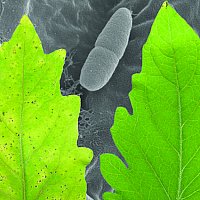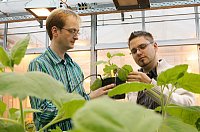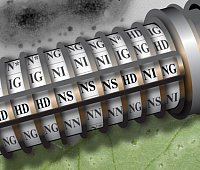Links
Contact
Dr. Jens Boch
phone: 0345 55 26292
jens.boch@genetik.uni-halle.de
Institut of Biology
Section of Plant Genetics
MLU
06120 Halle (Saale)
Fight against pathogen: plant geneticists make decisive breakthrough
Scientists crack the code that bacteria use to manipulate agricultural crops
The Xanthomonas bacteria is the name of the pathogen that has led to the loss of many crops in Asia, America and many other hot and humid areas. It attacks important cultivated plants such as rice, peppers, tomatoes and citrus fruits by manipulating the genes of these plants. Biologists at the Martin Luther University Halle-Wittenberg (MLU) have now figured out how the pathogen does this. In this week's Science Express, the advance online version of the renowned Science magazine, they reveal the secret behind this special code that Xanthomonas uses to manipulate genes. Knowing this code is imperative when it comes to breeding resistant plants.

A tomato plant leaf infected by Xanthomonas showing symptoms of the disease (left) compared to a healthy tomato plant leaf (right). Behind this is a scanning electron micrograph of Xanthomonas bacteria inside the leaf of a plant. (Image: Sebastian Schornack, Gerd Hause, Jens Boch)
This seminal discovery has high application potential, particularly for biotechnology. “With the help of this study, factors could be developed for the first time that specifically regulate any type of plant gene,” says Dr. Jens Boch, main author of the Science magazine’s article. “We still have to see whether this principle works only with plants, or whether it can also be transferred to animals and people,” Boch adds.
The scientists from the Institute of Biology at MLU discovered a new, unique patter after binding proteins from the causative agent to the DNA of the plant. “It works a bit like a zipper. In the right combination, these proteins target the DNA within the nucleus of the plant’s cells,” explains Prof. Ulla Bonas, director of the Department of Plant Genetics. With the help of this pattern – left undiscovered until now - proteins can now be manufactured which target specific areas of the DNA. “Up until now it was impossible to create a protein that precisely bound itself to a specific DNA sequence,” Bonas emphasizes. In Science, the scientists from Halle prove that this is possible.

Dr. Jens Boch and Dr. Sebastian Schornack with tobacco plants as test objects.
(Photo: Maike Glöckner)
Xanthomonas uses a sophisticated strategy to colonize the plant. It injects proteins directly into the nucleus of the cells in order to manipulate the plant’s gene activity. A large and important group of these proteins are so-called TAL effectors. Just how the TAL effectors were able to recognize the target gene of the plant they affected had been a puzzle. To their astonishment, Dr. Jens Boch and Dr. Sebastian Schornack, scientists at MLU, stumbled upon a direct correlation between individual modules in the effectors and the DNA building blocks. “The principle is extremely simple and therefore very elegant. A series of modules in the TAL proteins exactly matches the corresponding DNA building block sequence,” Boch explains. Unlocking this code now allows predictions to be made as to how Xanthomonas triggers diseases in plants and through this, enables the breeding of disease resistant plants. The unique modular structure also enables proteins that bond with any type of DNA to be manufactured in a laboratory.

The code, depicted as Kryptex, which Xanthomonas proteins use to bind to DNA. In the background is a scanning electron micrograph of Xanthomonas (above) and a tomato plant leaf infected by the pathogen (below). (Image: Sebastian Schornack, Gerd Hause)
For twenty years, the Department of Plant Genetics at the MLU’s Institute for Biology, headed by Prof. Ulla Bonas, has been researching into the interaction between Xanthomonas and pepper and tomato plants. She initiated the investigation of the pathogen which led to the deciphering of the code. In 2007 Bonas and her colleagues revealed in two “Science” publications that the protein AvrBs3 binds to DNA. The scientists at MLU have been funded by the German Research Foundation as part of the SPP 1212 program and the 648 collaborative research center.
The paper is now online at the Science Express web site. See http://www.sciencexpress.org



